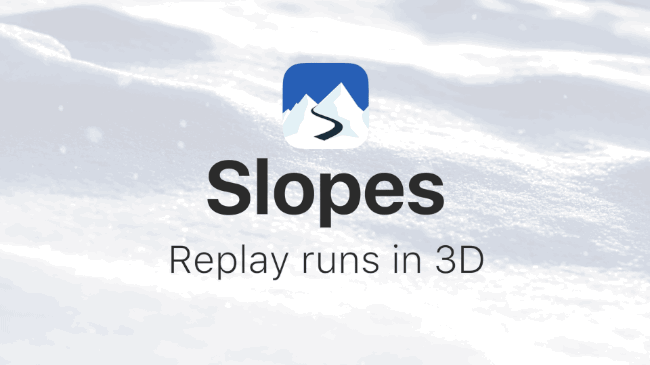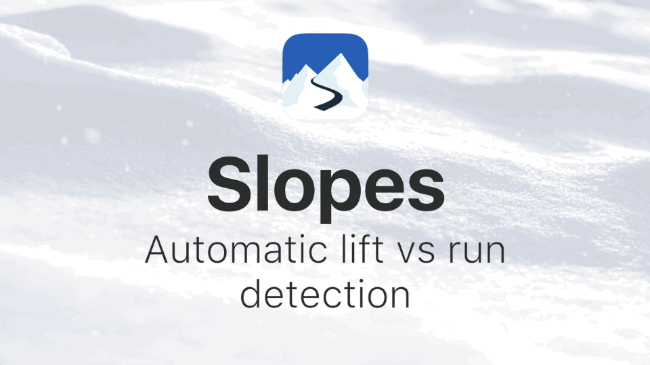Slopes Diaries #18: That Dirty M Word
Slopes Diaries is my ongoing journey to turn my indie app into a more sustainable part of my business. First time reading? Catch up on the journey so far.
What is Slopes? Think Nike+, Runkeeper, Strava, MapMyRun, etc for skiers and snowboarders.
Marketing. That thing everyone knows they should do, but usually ends up being back-burnered. Before Slopes 2.0 (when I was paid up front), I had only tried the "traditional indie" app marketing plan: build a decent web site, focus on building the app, and finally get around to emailing the tech press when I was one week away from launching.
The results of this approach were underwhelming. It might work well for individuals / companies who by default get attention from the press, but for a relative unknown it yielded very little results (for reasons outlined in my Indie's Guide to the Press).
Since Slopes 2.0 launched in Nov '15 I've tried to make an effort to at least try to market. As an indie, paying for marketing feels odd. The default urge is to spend the money on services / hardware needed to run the app only and keep the rest, not use some of that revenue to acquire users. But the reality is, we need to market. And we need to market where our users spend their time, not where we spend ours.
I want to hit on some take-aways and realizations I've had this last year+ in online marketing as an indie.
Start Small and Experiment
There are so many advertising channels, so many approaches, that you can't expect to get it right the first time, or the second. If you went all-in and big-budget on your first attempt you'll likely be out a lot of money.
Instead you need to do research first.
With this notion comes something that may feel weird: you need to be comfortable spending some money just to learn what your market responds to. I am my own market, and yet my first attempts converted terribly.
You can't skip this step. As much as you think you might, you don't know if a screenshot will work. If text on the image will work. If a fancy stock-image of someone from your niche will work. You don't know what message will work yet, and you don't know how to target yet.

I started playing around with ~$10/day in Dec 2015. That might seem small, but with even just that I learned a lot. As a bonus it was a small enough amount that I wasn't hung up on "wasting money", helping me slowly get OK with the idea of spending money on advertising.
One of the (many) things I tried was Facebook app install ads. I did so early enough in the season (Dec) to leave time to learn from my results before I really needed to have an effective at-scale campaign in Jan / Feb.
A budget of $10/day (moving up to $20/day as I found effective targets I wanted to try more variations on) gave me enough room to play around with the two main knobs to turn within install ads: the "creative" (the ad image and the copy around it) and the audience. Over a one-month period I tried all kinds of permutations, re-visiting my ads every day or two to turn off the clear losers to save money, and try new ones. Looking back at the ad manager for that time period my worst permutation was going to cost me $20 a user, and I had a lot in the $2 - $5 range, but by Jan 2016 I knew how to dial some of the knobs get users for < $1.
I went through this process again for the 2016/2017 season; what worked last year fortunately still worked pretty well this year, but some new audience refinements really drove the cost down even more.
Targeting
I was surprised just how much the proper audience targeting had an effect on my cost. Where one creative might absolutely flop for one audience, it might excel for another.
Initially I tried a bunch of the obvious ones: people who had shown an interest in skiing or snowboarding. On Reddit this was easy: advertise on /r/skiing and /r/snowboarding (PSA: cheap, but low volume). On Facebook target people who like those or some other winter sports. But it gets so much deeper than that. You can't stop there.
One of the most effective ad targets I found on Facebook was to target people who liked a certain group of ski resorts, and work my copy around that. "Going to XYZ this weekend? Grab your bragging rights."
Another thing I tried: if competitors have Facebook pages (and they are big enough), try targeting people who have liked them and then craft a message around that (bypassing the need to have a creative that educates people unfamiliar with your app niche exists). In my case: "Grab all the stats XZY misses. Speed, distance, and more!"
A new technique I found success with this year was Facebook lookalike audiences. If you have a decent-sized seed of people (say, a mailing list) you can have Facebook build an audience target that is similar. I tried this in Feb 2016 with mediocre results (my mailing list was just hitting ~2k users), but this year with 8k users it was much much more effective.
Try New Platforms and Formats
One platform that blind-sided me in Feb 2016 was Instagram. Facebook had recently started to allow you to cross-post ads from Facebook to Instagram, and I figured what the heck, why not?
Turns out Instagram is one of my most effective advertising platforms. I didn't realize just how active skiers and snowboarders where there, but it makes sense; the sport has a very visual component to it when it comes to sharing.
This year I continued with that experiment with video ads on Youtube. My friend Alice had been bugging me to try it for over a year, and it made sense. Skiers and snowboarders watch a lot of videos about the sport (think: GoPro videos), so it seemed like a perfect fit.
I've only gotten a few hundred downloads from that ad, but it cost me all of $10 to run for a month so far. (The limiting factor seems to be my targeting, I'm not blowing through budget, I just haven't figured out good AdWord targeting yet.) But I ran it on Instagram (another "heck, why not?") and it did pretty well.
Still a lot to learn with making catchy videos and optimizing this, but it is a good start that I can build upon next year.
An easy-ish extension from video is animated gifs. Small, bite-sized videos, highlighting just one feature. I've loved how the email client Spark uses this concept on Twitter to advertise features, so I shamelessly borrowed the idea for my own format. I don't run them as ads per se, instead I use them to help educate users about features via social media, or highlight new ones in a release. I've found that attaching one of these to a "version 2.5 is out!" post really helps engagement vs just a text link to the post itself.


App Store Ads
I saved my $100 credit from Apple for the winter season, letting everyone else blow through their free credits back in Sept / Oct when people aren't searching for ski apps anyway. I felt waiting was important because the free credit was going to skew CPAs, and make any experiments I ran less accurate.
So far, App Store Ads have been pretty effective for me this season. I have an $0.80 bid across the board for my 13 keywords, but my average CPA is half that. For my high-traffic keywords that eat up my budget the quickest, I'm actually looking at an even lower average of $0.30 per install.
Targeting competitors as a keyword has been a mixed bag for me. One of my free competitors costs me $0.75 per install as a keyword, while another costs me $0.37. However targeting my very popular $0.99 competitor costs me $0.25 per install and is pretty high-volume (people love free alternatives).
One thing I'm not doing is bidding on my own name as a keyword. I'm not sure the right answer here, but my take: I'd rather spend my money making unaware users aware of me than fighting to keep attention. I don't have any obvious barriers (paid vs free) to download, so I'll play those odds.
I know there was a lot of debate over if ads are good or bad for indies, but in my book, they've been a net-win and a source of over 2,000 new users.
Embracing Advertising
Advertising has indirect effects, too. You might "buy" 2,000 users over the course of a few months, but if those extra downloads push you up in the App Store top charts rank, you'll now be getting extra organic downloads. You can even test ad spend to find out how much you need to spend to be in the top-50 or top-20 for your category, which will still get you notifiable boosts in organic downloads.
If you have an app with some traction and you can afford to (a privilege I know not everyone has), I'd get comfortable with the idea of re-investing at least 10% of its revenue back into marketing (assuming your in-app conversion rate is decent! don't fill the top of your funnel if you have <1% of converting a download to a paid user).
Even if you don't have that kind of traction yet, I'd still spend a little every day to learn your market and find the techniques that will eventually work for you when you need them to.
Over all my ads this season I'm seeing a $0.42 cost per new user, which includes money spent on learning through ad experiments. That is better than my average lifetime value per user. Ad-based downloads have only accounted for ~7% of this year's new uses, but that's still 7% growth vs without spending money on ads, especially considering these ad-acquired users will bring in more value than the ad-spend in the long run.
Not bad, considering when it comes down to it I have no idea what I'm doing. I feel like I'm constantly flailing with this, but it's OK to feel like that, that's how you learn.
Next stop: Slopes, the Super Bowl Ad.
(hashtag get slopes)